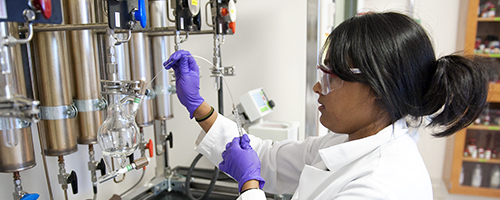Document Type
Article
Publication Date
3-28-2019
Publication Title
Bioconjugate Chemistry
Abstract
Conjugation of proteins to drug-loaded polymeric structures is an attractive strategy for facilitating target-specific drug delivery for a variety of clinical needs. Polymers currently available for conjugation to proteins generally have limited chemical versatility for subsequent drug loading. Many polymers that do have chemical functionality useful for drug loading are often insoluble in water, making it difficult to synthesize functional protein–polymer conjugates for targeted drug delivery. In this work, we demonstrate that reactive, azlactone-functionalized polymers can be grafted to proteins, conjugated to a small-molecule fluorophore, and subsequently internalized into cells in a receptor-specific manner. Poly(2-vinyl-4,4-dimethylazlactone), synthesized using reversible addition–fragmentation chain transfer polymerization, was modified post-polymerization with substoichiometric equivalents of triethylene glycol monomethyl ether to yield reactive water-soluble, azlactone-functionalized copolymers. These reactive polymers were then conjugated to proteins holo-transferrin and ovotransferrin. Protein gel analysis verified successful conjugation of proteins to polymer, and protein–polymer conjugates were subsequently purified from unreacted proteins and polymers using size exclusion chromatography. Internalization experiments using a breast cancer cell line that overexpresses the transferrin receptor on its surface showed that the holo-transferrin–polymer conjugate was successfully internalized by cells in a mechanism consistent with receptor-mediated endocytosis. Internalization of protein–polymer conjugate demonstrated that the protein ligand maintained its overall structure and function following conjugation to polymer. Our approach to protein–polymer conjugate synthesis offers a simple, tailorable strategy for preparing bioconjugates of interest for a broad range of biomedical applications.
Volume
30
Issue
4
First Page
1220
Last Page
1231
DOI
doi.org/10.1021/acs.bioconjchem.9b00155
Creative Commons License

This work is licensed under a Creative Commons Attribution 4.0 International License.
Rights
Licensed to Smith College and distributed CC-BY under the Smith College Faculty Open Access Policy.
Version
Author's Accepted Manuscript
Recommended Citation
Kim, Julia S.; Sirois, Allison R.; Vazquez Cegla, Analia J.; Jumai'an, Eugenie; Murata, Naomi; Buck, Maren E.; and Moore, Sarah J., "Protein-Polymer Conjugates Synthesized Using Water-Soluble Azlactone-Functionalized Polymers Enable Receptor-Specific Cellular Uptake Toward Targeted Drug Delivery" (2019). Chemistry: Faculty Publications, Smith College, Northampton, MA.
https://scholarworks.smith.edu/chm_facpubs/18


